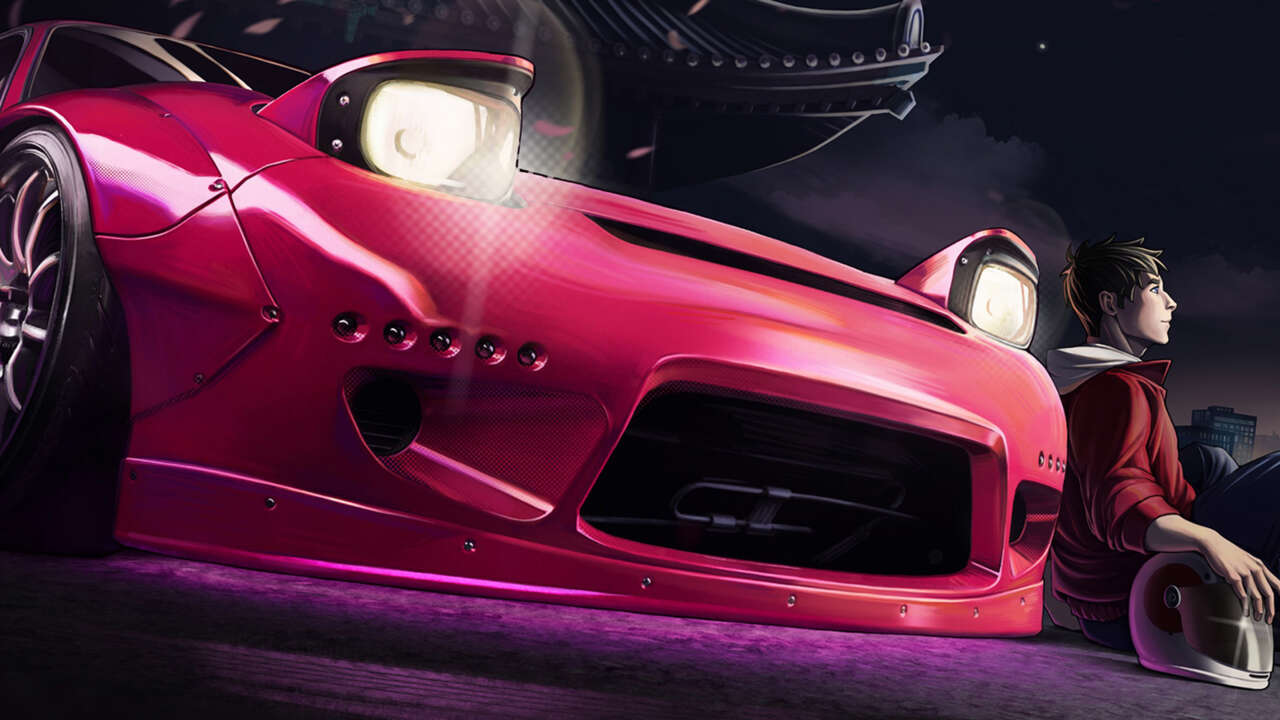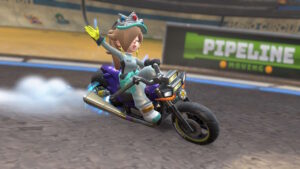If there are two things that have been missing from the modern slate of racing games, it’s a focus on drifting and Japanese settings. Yes, arcade racers like Forza Horizon have travelled across the world, from Australia to Mexico and everything in between, but have yet to visit the bustling streets of Tokyo or the rich countryside across Kyoto. That series also doesn’t dabble in the kind of street-racing culture popularised by games like Need for Speed or films such as the earlier Fast and the Furious entries, sticking closely to flashy but strictly stock configurations of popular cars. With that said, it’s easy to see the gap JDM: Japanese Drift Master is trying to fill, carving out its own niche with a driving model heavily tuned towards challenging and satisfying drifting, set against a condensed and well-realised slice of Japan. It’s such a shame then that the sum of all of its disparate parts don’t come together in a cohesive way.
Drifting is primarily what Japanese Drift Master is all about, and it’s easily the strongest aspect of the game. Whipping a rear-wheel-drive, torque-filled machine into a controlled slide is simple, but it’s maintaining a good angle and adequate speed that make it engaging. A balance meter, similar to one you’d find during a grind in Tony Hawk Pro Skater, helps you gauge the angle of your drift and deftly balance it, steering into the direction the back of your car is facing while gently applying the accelerator to power through the slide. It feels good to figure out how to expertly control a drift, and even better when you can use the handbrake to quickly change angles or drop the clutch to provide a little more torque through a corner.
Drift events let you showcase your understanding of Japanese Drift Master’s driving model the best, but they’re also some of the easiest events the game has to offer. Racking up a high enough score to pass was rarely an issue for me in most events, but also came down to some frustrating luck in some instances. The longer and more aggressively you drift, the higher your score multiplier climbs, resetting if you spin out or suffer a collision. The issue isn’t that this happens at all, but rather how inconsistently it does. Japanese Drift Master feels overly punishing with the angle at which it judges a spin, sometimes resetting your score unfairly if you enter a drift at an angle it isn’t anticipating. Similarly, it isn’t clear which collisions reset your multiplier and which don’t. I had instances where I hit road barriers hard without seeing my score disappear, and others where the lightest touch by traffic would end a particularly long one. Without being able to depend on knowing the limitations of what I could get away with in a drift, it became frustrating trying to find the absolute limit that I could push myself without wasting time in the process.
Japanese Drift Master is still, at its core, an arcade racer, although it does demand a higher level of patience when it comes to drifting compared to its peers. It offers two modes, namely simcade and arcade, which are meant to alter the difficulty in this regard. In practice, however, I struggled to feel much of a difference between the two, and it was only when toggling on a specific assist to help correct a spin that I felt a distinctive change. That had the knock-on effect of making drifting far more challenging, since the car would actively fight getting into a spin, which explains why the option is disabled by default in both modes. So you’re ultimately given little wiggle room to customize Japanese Drift Master’s approach to racing, which can leave you wanting if you find it either too forgiving or too challenging to get comfortable with.
Where Japanese Drift Master and its brand of driving further struggles is in any event not to do with drifting exclusively. There are some missions where drifting and traditional racing are blended together, challenging you to both finish in a specific time but also to do so while generating a high drift score. These two ideas clash instantly, provoking some ugly drifting by wagging the tail end of your car back and forth as you race forward in a straight line as a means to satisfy both requirements. Racing-first events are worse still, with nothing but a few front-wheel-driving cars even viable in the events. Anything slightly tuned for drifting will be impossible to compete with in a field of drivers that either race off into the distance or, infuriatingly, never try to avoid collisions, resulting in far more race restarts than you’d be amused by. It’s easy enough to swap cars at the nearest garage that you can fast-travel to, but it’s annoying to have time wasted by mislabelled events that don’t accurately convey what type of race you’ll be in, or multi-staged ones that hop between different racing principles without letting you swap cars in between.
It’s also impossible to get the most out of Japanese Drift Master without engaging with events that aren’t that fun. The campaign is a lightly story-driven one, with the events playing out across manga pages that bookend most story events. The story itself is largely forgettable and varies wildly in tone, ranging from mildly entertaining to cringeworthy in just a handful of pages. It’s largely just a vessel to usher you from one event to the next. It loosely provides context for why you might be using your drifting skills to entertain a passenger as you drive them home, or deliver orders of sushi to help fund your races around a track. Outside of the campaign, however, there’s not all that much to do. You can do side quests that mimic events you’ve already completed in the campaign or partake in underground drifting events where you place bets on your performance, but after the roughly 12 hours it takes to complete the story, there’s little reason to stick around.
The open world should provide some degree of entertainment in itself, and it can if you’re mostly looking for a means to escape into the most eye-catching elements of the country’s culture. This condensation of the most eye-catching aspects of both suburban and city life is a treat to take in. Neon lighting illuminating the streets at night or tight, twisting mountain roads littered with the soft pink hues of cherry blossom trees beside them make exploring the different corners of the open world a treat, with a surprising amount of variety for a map size that is noticeably smaller than games like Forza Horizon or The Crew. But for as much as it looks good, Japanese Drift Master’s world also feels barren.
There’s traffic that always seems too dense in the narrow streets of small towns, making it difficult to enjoy drifting around hairpins without disabling traffic entirely in the options menu. Traffic is also oddly absent in the wider highways of the main city, making what should be a bustling hive of activity feel mostly dead. Navigating this world is also undone by unpredictable physics, making it difficult to judge which objects are destructible and which will send you flying ridiculously through the air if you touch them. For each moment that you’re spellbound by the idea of racing through this version of Japan, you’re rapidly brought down to earth by the reality of it not being an engaging map to actively drive through most of the time.

Customization is another facet of street racing that Japanese Drift Master fully embraces, with a dizzying number of options for both performance and visual enhancements. There are upgrades that let you tweak the angles at which your front and back wheels face to alter the flexibility of your drift, for example, and more straightforward ones that just add a bunch of horsepower to your engine to power through slides more effectively. These options do, however, feel like they’re meant to service a simulation experience that Japanese Drift Master isn’t able to provide, making a lot of the complex options feel superfluous. Visual customization is a different story, with body kits, rims, spoilers, paint jobs, underglows, and even gear-shift heads available for purchase. You can get lost in the number of ways you can style Japanese Drift Master’s otherwise meagre 22-car offering, kitting your favourite Mazda, Subaru, or Nissan in ways that not many other racers offer anymore. Earning the required money to finance all of these purchases can feel like a grind, especially when some parts are tied to individual car levels, but it can make each new part you attach to your favourite ride feel hard-earned.
There were so many aspects of Japanese Drift Master that I desperately wanted to love, especially given that so few racing games hone in on drifting as a mechanic anymore like it attempts to. But in focusing so heavily on getting drifts to feel great (as they often do), all its other parts have been left to the wayside. The scale of its ambition is clear, but in trying to cater for a variety of event types, it undermines its most compelling mechanic, and continually reminds you how inadequate it is at supporting racing styles outside of that narrow focus. It’s a racer that, more often than not, doesn’t bring about the joy of tearing through the streets in a blazing-fast car, wasting its otherwise captivating setting with roads that don’t support that fantasy. JDM: Japanese Drift Master can look good in small snippets, but it’s sorely lacking as a complete package.









